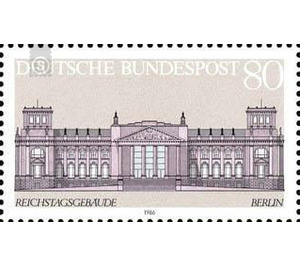Block stamp: Basic ideas of democracy - Germany / Federal Republic of Germany 1986 - 80 Pfennig
Theme: Architecture
| Country | Germany / Federal Republic of Germany |
| Issue Date | 1986 |
| Face Value | 80.00 |
| Color | brown |
| Perforation | Ks 14 |
| Printing Type | Six-color offset printing |
| Stamp Type | Postage stamp |
| Item Type | Stamp |
| Chronological Issue Number | 1160 |
| Chronological Chapter | GER-BRD |
| SID | 412905 |
| In 19 Wishlists | |
The issue of the stamp block wants to bring closer the recent history of the Federal Republic of Germany. It concludes the series entitled "Basic Thoughts of Democracy", which began in 1981 with the three special stamps "Rule of Law," "Separation of Powers," "People's Sovereignty," the stamp block "Federal President of the Federal Republic of Germany," as well as the Federal Government, Länder, and Local Authorities in the Federal Republic of Germany. , "Equal Rights of Men and Women" and "30 Years of the Bundeswehr". The history of the Federal Republic of Germany is the history of the resurgent parliamentary democracy. The stamp block "Important Buildings in the History of the Federal Republic of Germany" makes that clear. These stamps with representations of the Reichstag, the Museum Alexander Koenig and the Bundeshaus should inspire thinking about history. The building of the German Reichstag in Berlin, which was completed in 1894 after a ten-year construction period, indicates that the history of parliamentary representation in Germany dates back to the last century. This building also bears witness to the history. On the balcony of the Reichstag on 9 November 1918, Philipp Scheidemann proclaimed the republic. And in the Reichstag the last arguments about the assertion of democracy took place. The burning of the Reichstag on February 27, 1933, also marked the end of parliamentary democracy and the beginning of a totalitarian, criminal tyranny. The reconstruction of the Reichstag building between 1957 and 1971 was a sign of overcoming the defeat of the rule of law. During the partition, the Reichstag was a symbol of our solidarity with the free part of Berlin and a reminder of the unity of Germany. Stamps reflect contemporary history. This series of important buildings in the history of the Federal Republic can help to raise the awareness of the citizens of our state that they live in a liberal parliamentary democracy that has grown and is supported by the consent of the citizens. (Text: The President of the German Bundestag, Bonn)


